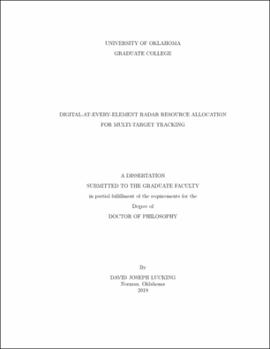| dc.contributor.advisor | Goodman, Nathan | |
| dc.contributor.author | Lucking, David | |
| dc.date.accessioned | 2019-06-21T20:11:00Z | |
| dc.date.available | 2019-06-21T20:11:00Z | |
| dc.date.issued | 2019-05 | |
| dc.identifier.uri | https://hdl.handle.net/11244/320358 | |
| dc.description.abstract | A sensor's performance is constrained by the amount of resources at its disposal and the utilization of those resources. A radar system, for example, has a limited amount of transmit power-aperture per unit time to track a multitude of targets. A typical approach when tracking multiple dynamic targets is to time interleave the update intervals until all the radar tasks are performed. The advent of more agile sensors, such as digital-at-every-element apertures, opens the possibility for dynamic sensor resource allocation strategies to achieve better tracking performance in target-dense, resource-constrained scenarios. With proper research into aperture allocation, such as the analysis provided in this dissertation, an all-digital radar can intelligently exploit the degrees of freedom offered by all-digital radars to increase tracking performance. In this dissertation, we investigate adaptive aperture allocation for tracking a large number of targets. The strategies are first introduced with a parallel, linear channel model, then increased in realism with a non-linear measurement model, and finally applied to a full tracking system. We derive various strategies for allocating power and aperture, and compare their performance based on tracking related metrics. Finally, we investigate the relationship between the aperture allocation strategies and the target locations for multiple scenarios designed to represent the environment for a radar tracking system. This research provides groundbreaking strategies for optimal radar aperture allocation using the digital-at-every-element architectures to reduce the overall system uncertainty and decrease the uncertainty on a per-target basis. Integrating aperture allocation with the management of other degrees of freedom will increase multi-target tracking performance well beyond the current state of the art. | en_US |
| dc.language | en_US | en_US |
| dc.subject | Digital Arrays | en_US |
| dc.subject | Multi-Target Tracking | en_US |
| dc.subject | Radar Modeling | en_US |
| dc.subject | Radar Resource Management | en_US |
| dc.subject | Radar Signal Processing | en_US |
| dc.title | Digital-At-Every-Element Radar Resource Allocation for Multi-Target Tracking | en_US |
| dc.contributor.committeeMember | Fulton, Caleb | |
| dc.contributor.committeeMember | Yeary, Mark | |
| dc.contributor.committeeMember | Antonio, John | |
| dc.contributor.committeeMember | Sigmarsson, Hjalti | |
| dc.date.manuscript | 2019-05-09 | |
| dc.thesis.degree | Ph.D. | en_US |
| ou.group | Gallogly College of Engineering::School of Electrical and Computer Engineering | en_US |
